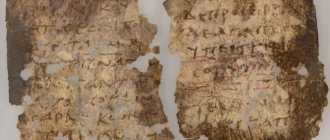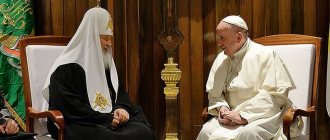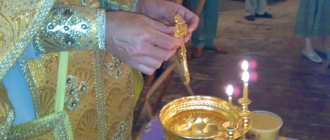Autocephaly of the Russian Church
The Greek word “autocephaly” is made up of two, where “auto” is itself in Russian, and “mullet” is head and in free translation means head to itself. When applied to the church, it means self-government in the election of the patriarch, in the appointment of metropolitans and in the entire way of life of the church community.
Gaining autocephaly of the Russian Orthodox Church
The Russian Church walked towards its independence for almost 500
years.
During this time, the borders of the principalities changed, the Mongol-Tatar raids, and Byzantium collapsed. Pressure on Orthodox Rus' from Catholic Rome increased. The Patriarchate of Constantinople sent Greek metropolitans as primates of the Russian Orthodox Church; only twice
in half a thousand years did they elect a metropolitan themselves.
The acceleration of the collapse of Orthodox Byzantium forced the Patriarch of Constantinople to seek the patronage of the Pope. Rus' was politically independent of these intrigues; it stewed in its own strife, remaining the only Orthodox country. Despite all the quarrels of the princes, she always maintained her integrity in Orthodoxy.
When the next appointed primate, Metropolitan Isidore, signed the 1441
In Rome, a union with the Catholic Church was expelled and the church was without a leader.
Almost 8
years later, a council of bishops in Moscow elected Ryazan Bishop Jonah as Metropolitan of All Russia.
On December 5 1448
, the independence of the Russian Orthodox Church began, and a Russian metropolitan was solemnly installed as a Russian metropolitan. The reason for autocephaly was the apostasy from the Orthodox faith of the Greek appointee.
Recognition of this event did not come immediately, but from that moment on, the Metropolitan of All Rus', and then the Patriarch, was elected to the Russian Orthodox Church. The fall of Constantinople, the collapse of the Byzantine Empire and the fact that the Church of Constantinople came under the influence of the Turkish Sultan further strengthened the independence of the Russian Orthodox Church from external influences. But the independence, wealth and spiritual power of the church within the country did not suit the reformer Tsar Peter the Great.
Public administration of the Russian Orthodox Church after the reform of Peter the Great
In order to transform the country in a short time to the level of European states, it was necessary to mobilize all the country's resources. In addition, the power of the patriarch was very strong and the church was in no hurry to share it and its wealth to carry out reforms. After consultations with Patriarch Dosifei of Jerusalem and Ecumenical Patriarch Kosmoy, Tsar developed and carried out a reform of church life over the course of 20
years.
Independence (autocephaly) within the country was ended. The end of the church reform can be considered the abolition of the patriarchate
January 25 1721
. The main results of the changes: - the management of the church is carried out by the Governing Synod with a secular official at its head; - confiscation of many church lands due to the reduction in the number of monasteries; - the church began to pay taxes; - church peasants, and often monks, are taken into conscription and labor service; - transformation of the church into another pillar of the emperor’s sole power.
The subordination of priests, like other officials, to the authorities led to interference in church rituals, in particular in the sacraments of confession. They were entrusted with the duty, under pain of death, to identify those who were dissatisfied and report where they should about what they heard in confession. It was also required to glorify the tsar and his reforms in sermons. The authority of the church began to decline and distrust accumulated almost 200
years.
The positive results of the reform include freedom of religion for Protestants and Catholics, and the harsh persecution of Old Believers has decreased. Factories, hospitals, and almshouses for disabled soldiers began to open at the monasteries. Schools and religious schools began to open at churches.
The reform of Peter the Great determined the life of the church for two hundred years and returned to autocephaly within the country with the abolition of autocracy.
Attitude to the independence of the church under Soviet rule
The Bolshevik government in January 1918
legalized the separation of the state and schools from church influence.
These are, in principle, progressive constitutional norms of secular states. However, by the same decree, the Russian Orthodox Church and other religious organizations were deprived of their legal personality and their property was declared the property of the people. Since 1920
, a bloody terror was unleashed against the church. The destruction of churches, the destruction of icons and church books was accompanied by the execution of thousands of clergy and millions of Orthodox people imprisoned in camps or exiled.
Militant atheists so zealously set out to eradicate religion that by the beginning of the Great Patriotic War there were about a hundred active churches left. The mobilization of all the country's resources for victory softened the relationship between church and state. Many priests, including those repressed, stood up to defend the Motherland. At the front and in the rear, they strengthened the faith of Orthodox people in victory over the enemy. The Soviet state recognized the contribution of the Russian Orthodox Church to the victory by establishing 1944
year by the Council for the Affairs of the Russian Orthodox Church. In 1965 it was transformed into the Council for Religious Affairs.
Since the post-war period, the Orthodox Church in the USSR developed in parallel with the entire state, whose position sometimes became tougher, but was mostly peaceful. Any state that announces the separation of the church will still monitor the mentality of some of its citizens, united in significant communities. But on Easter, it was not only in distant villages that young pioneers and Octobrists ran from house to house to glorify Christ. Baptism of newborns was also everywhere, although it was not advertised. It became possible to receive religious education in theological seminaries and academies.
Autocephaly of the Church after the collapse of the USSR
After the collapse of the USSR, the position of the Russian Orthodox Church strengthened not only in Russia, but also in the world.
Most of the newly formed states do not interfere in the affairs of local churches, and they maintain unity in Orthodoxy. The foreign church reunited in service with the Russian Orthodox Church. Through the efforts of Patriarch Alexy II, the church acquired a higher status than before the revolution. Services have resumed in old and newly built churches. The state, having declared patriotism to be the only ideology, tries to support traditional religions, realizing that the emptiness in souls will not last long. In some states, religious unrest has resumed for the sake of political interests. The Patriarchate of Constantinople has become more active in relation to the ROC MP, but the unity and autocephaly of the ROC in the Orthodox world is still largely preserved.
Thanks to television, the Internet and other media, the words “autocephaly” and “tomos” are now known not only to priests and believers, but also to atheists, young and old. In ancient times, the harm of fuss around these words concerned mainly the elite and took a long time to reach ordinary people. Now any event overtakes everyone quickly and the split is much more destructive than before. Exorbitant ambitions and greed are difficult to hide behind church robes in the modern world. This is not from God.
Betrayal of the Kyiv Metropolitan
In 1439, an agreement was signed in Italy between representatives of the Greek Orthodox Church and the Roman Catholic Church. It went down in history under the name of the Union of Florence. Formally pursuing the goal of uniting the two leading directions of Christianity, it actually served to further separate them, since it assumed, albeit with some reservations, the primacy of the Pope over the Orthodox Church.
In Rus', this document, signed by the majority of representatives of the Byzantine delegation, was perceived as a betrayal and violation of the foundations of the Orthodox faith. When the main initiator of the conclusion of the union, Metropolitan Isidore of Kiev and All Rus', who by this time had become the papal legate (plenipotentiary representative), arrived in Moscow, he was immediately arrested by order of Grand Duke Vasily II and imprisoned in the Miracle Monastery, from where he then fled to Lithuania.
Glorification among the saints
Metropolitan Jonah completed his earthly journey on March 31 (April 12), 1461. The life says that immediately after his blessed dormition at the tomb, numerous healings of the sick began to occur, as well as other miracles. When, ten years later, it was decided to rebury the metropolitan’s remains in the Assumption Cathedral of the Kremlin, then, taken out of the ground, they did not bear any traces of decay. This indisputably testified to God's grace sent down to the deceased.
In 1547, by the decision of the next Council of the Russian Church, Metropolitan Jonah was canonized. The day of remembrance was May 27 - the anniversary of the transfer of his incorruptible relics under the arches of the Assumption Cathedral. Nowadays, the memory of St. Jonah, Metropolitan of Moscow and All Rus', is also celebrated on March 31, June 15 and October 5 according to the new style. For his contribution to the development of Russian Orthodoxy, he is recognized as one of the most honored religious figures in Russia.
In the context of new historical realities
It is important to note that autocephaly was not proclaimed by Metropolitan Jonah. Moreover, Prince Vasily II, a very skilled man in diplomacy, conducted the matter in such a way that Constantinople did not doubt his intention to revive the previous tradition of electing metropolitans pleasing to their patriarch. All this helped to avoid then unnecessary complications.
When in 1453 the Byzantine capital was captured by the troops of the Turkish Sultan Mehmed the Conqueror, the new Patriarch of Constantinople Gennady II, elected with his permission, was forced to moderate his claims to spiritual leadership, and the undeclared autocephaly of the Russian Church was established by the very course of historical events. It received its legal justification in 1459, when the next Church Council decided that to elect a high priest, only the consent of the Moscow prince was necessary.
Favorable coincidence of circumstances
Fortunately, the political situation soon developed in such a way that it excluded the possibility of such a negative scenario developing. First of all, Metropolitan Jonah played into the hands of the fact that the attempts of Metropolitan Isidore, who fled to Lithuania, to remove the western dioceses from the control of the Moscow Metropolis and persuade their population to accept the union ended in failure. He was prevented from doing this by the Polish king Casimir IV, who, by coincidence, broke off relations with Pope Eugene I during this period.
When he died in 1447, Pope Nicholas V became head of the Catholic Church, and King Casimir IV restored relations with Rome. However, even at this stop, the fugitive Isidore was unable to realize his insidious plans, since the idea of union found fierce opponents in the representatives of the Polish clergy.
Prophecy of Saint Photius
An episode described in his life, compiled shortly after the canonization of Metropolitan Jonah, who died in 1461, dates back to this period of his life. One day, Moscow High Hierarch Photius (who also later won the crown of holiness) visited the Simonov Monastery, and looking into the bakery, he saw the monk Jonah, who had fallen asleep from extreme fatigue.
The matter is, in general, an everyday matter, but the high priest was amazed that in a dream the young monk was holding his right hand (right hand) in a blessing gesture. Seeing future events with his inner eyes, the Metropolitan turned to the monks accompanying him and publicly declared that the Lord had prepared the young man to become a great saint and primate of the Russian Church.
It is difficult to talk today about how his ministry developed in subsequent years and the process of spiritual growth, since information about his future life dates back to 1431, when the monk, who so attracted the attention of Saint Photius, was installed as Bishop of Ryazan and Murom. Thus, the prediction made regarding him began to come true.
Grand Duke's message
Isidore still tried to intrigue as best he could and even turned to the Kyiv prince Alexander for military help, but no one took him seriously anymore. It was much more important for Metropolitan Jonah to achieve his recognition by Constantinople, since the attitude of the entire Orthodox world towards him largely depended on this. The initiative in resolving this issue was taken by the Grand Duke of Moscow Vasily II.
In 1452, he sent a message to the Byzantine Emperor Constantine XI, in which he very thoroughly outlined the reasons that prompted the Russian bishops to elect a metropolitan, bypassing the then prevailing tradition. In particular, he wrote that “it was not insolence” that forced them to neglect the blessing of the Patriarch of Constantinople, but only the extraordinary circumstances that had arisen at that time. In conclusion, Vasily II expressed his desire to continue to maintain close eucharistic (liturgical) communion with the Byzantine Church for the sake of the triumph of Orthodoxy.
The futile labors of the Ryazan bishop
In order to gain a foothold on the princely throne, Shemyaka needed the support of the clergy, and for this purpose he planned to make Bishop Jonah of Ryazan Metropolitan of Moscow. This choice was by no means a consequence of his personal sympathies, but the result of a subtle calculation. The fact is that Bishop Jonah twice previously tried to lead the Russian church, but both times he was unsuccessful.
In 1431, when Metropolitan Photius died, he claimed his place, but the Patriarch of Constantinople, who personally elevated him to the metropolitan rank, gave preference to the Smolensk bishop Gerasim. Four years later, when, due to his death, the position of primate of the Russian church again became vacant, Jonah hurried to Constantinople for the patriarchal blessing, but was too late. He was preceded by the same Metropolitan Isidore, who, by signing the Union of Florence, basely betrayed the interests of the Orthodox Church.
The struggle for the grand ducal throne
After his arrest and subsequent escape, the position of head of the Russian metropolitanate remained vacant due to a number of political and military upheavals that befell the state. In 1445, the Russian lands were engulfed in an internecine war for the grand-ducal throne that broke out between Vasily II and Dmitry Shemyaka, which Khan Ulug-Muhammad did not fail to take advantage of. Hordes of Tatars invaded the Moscow principality and, having defeated a Russian squad in the battle of Suzdal, captured the prince himself. As a result, the grand-ducal throne became easy prey for his competitor.
Monk from Kostroma region
Considering the role that Metropolitan Jonah played in the history of the Russian Church, it is worthwhile to dwell in more detail on his personality. The future bishop was born in the village of Odnoushevo, not far from Kostroma. The exact date has not been established, but it is known that he was born in the last decade of the 14th century. The name given to him at birth by his mother and father, the service landowner Fedor, has not reached us either.
However, it is known for certain that the future Metropolitan Jonah felt a desire to serve God from early childhood and at the age of 12 he took monastic vows in a small monastery near the city of Galich. After living there for several years, he moved to the Moscow Simonov Monastery, where he served as a baker.









